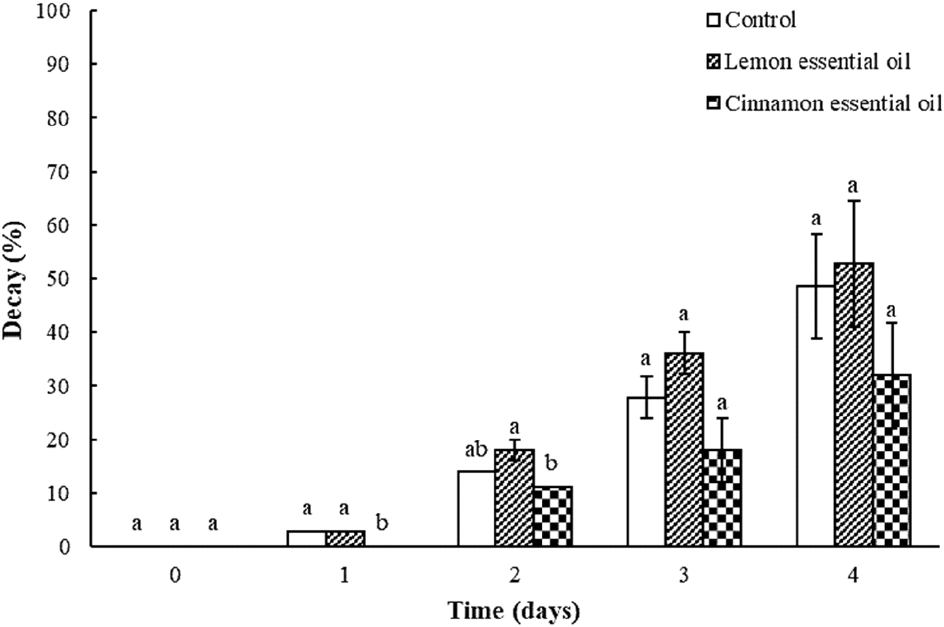1. Introduction
Strawberries (Fragaria×ananassa) are one of the most widely consumed fruits globally while being one of the most perishable food items. They are commonly consumed fresh and are favored for their rich taste and nutritional values (Shehata et al., 2020). However, they are very susceptible to microbial infections, especially to fungal pathogens. They are often discarded due to the loss of quality and fruit decay (Vitoratos et al., 2013).
Although many synthetic preservatives are effective against strawberry pathogens, consumers have gained an interest in natural and minimally processed foods, inciting the food industry to consider using natural products as preservatives (Fisher and Phillips, 2006). Therefore, organic compounds have gained in popularity for their potential applications in food production and are being investigated. Essential oils are attractive candidates to improve the quality of fruits during storage. They are extracts obtained from plants, and most of them are on the Food and Drug Administration’s (FDA) GRAS list. Lemon essential oil and cinnamon essential oil have antimicrobial properties, meaning they can prohibit the growth of many bacteria and fungi at low concentrations, such as Escherichia coli, Salmonella, and Botrytis cinerea (Al-Jabri and Hossain, 2016; Dimić et al., 2014; Fisher and Phillips, 2006; Umagiliyage et al., 2017; Vitoratos et al., 2013). Since their bioactive compounds vaporize easily, it allows sanitation via fumigation (Tzortzakis, 2007). However, the use of essential oil for preserving fruit quality still requires research. While many studies have shown their antimicrobial effects, only a few studies have shown the effects of lemon and cinnamon essential oils on the quality-related properties of fruits, especially strawberries.
Therefore, this research aimed to study the effects of essential oil vapor from lemon and cinnamon on the physicochemical attributes of strawberries, including visible decay, weight loss, texture, color, titratable acidity, pH, soluble solids, and reducing-sugar contents. The hypothesis is that strawberries treated with lemon or cinnamon essential oils vapor will have a decrease in weight loss and visible decay during storage, and other parameters will not be negatively affected. The analysis presented in this study will convey valuable information about the benefits of essential oils as fruit preservatives. Indeed, it brings new information regarding the use of essential oil vapor treatment to preserve fruits, and potentially decreasing fruit loss and waste along the food supply chain.
2. Materials and methods
Strawberries were purchased from a local grocery store. Sixty-three were selected for their absence of defects, and uniformity in weight, shape, and color. Organic essential oils of lemon (Citrus×limon; originating from Argentina) and cinnamon (Cinnamomum cassia; originating from China) were obtained from the Plant Therapy Essential Oils Corporation (Twin Falls, ID, USA). The purity of oils and extraction methods were verified by the suppliers.
Fifteen strawberries were placed inside a polystyrene container (Volume: 14.37 L) for each group: cinnamon treatment, lemon treatment and untreated strawberries. Essential oil of lemon or cinnamon was added to the container at a concentration of 100 ppm via seven Whatman No.1 filter papers (diameter: 7 cm). Filter papers without oil were placed in the control group. Volatile compounds were allowed to vaporize in the container for 12 h at a temperature of 4°C. After treatment, strawberries were moved to aluminum foil baking pans and stored at 22°C with 50% humidity for 4 days. Decay, weight loss, color, texture, pH, titratable acidity, soluble solids, and reducing-sugar content were measured each day for four consecutive days. Three replications were used for each analysis.
A similar protocol was replicated for a validation study, where two groups of nine strawberries were analyzed: cinnamon essential oil vapor treatment and untreated strawberries. They were stored at 4°C with 85% humidity for 18 d after treatment. Weight loss, color and soluble solids were measured with non-destructive testing strategies at day zero, three, seven, 14 and 18. Additionally, texture, pH, titratable acidity and reducing-sugar content were measured on the last day of the experiment.
Decay was visually evaluated following the exposure to oils. It was determined by evaluating the presence of mold on strawberries, using a scale from 0 to 4, where 0 refers to no decay; 1 refers to 1-25% decay (probable decay); 2 to refers 26-50% decay (moderate); 3 refers to 51-75% decay (moderate to severe); and 4 refers to 76-100% decay (extreme) (Kahramanoğlu, 2019). It was expressed in percentage, based on the methodology used by Cao et al. (2010):
where N is the total number of fruits measured and N1, N2, N3, and N4 were the number of fruits that had different level of decay.
After treatment with oils, the strawberries were individually weighed and labeled before being placed for storage. During the experiment, they were weighed every day using an analytical balance (OHAUS Co., Parsippany, NJ, USA). In the validation study, strawberries were weighed at day zero, three, seven, 14 and 18 days. The weight loss (WL) was calculated using the following formula:
where FW is the final weight and IW is the initial weight.
The surface color was determined by using a ColorFlex EZ Spectrophotometer (Hunterlab Inc., Reston, VA, USA). Areas selected for color measurements were free from obvious defects that may affect the uniform color readings. The results were expressed in the CIELAB color space, where L* value, a* value and b* value refer to lightness, red/green coordinate, and yellow/blue coordinate, respectively. Color was analyzed using lightness, chroma and hue. Chroma and hue were calculated with the following formulas:
Strawberry fruit firmness was measured using a QTS25 texture analyzer (Brookfield Co., Middleboro, MA, USA) with a cylindrical probe of 13 mm. Strawberries were cut in half and were placed on their flat surface. The force required to compress 5 mm of strawberry fruit was measured in Newtons.
Five grams of strawberry fruit was added to 15 mL of distilled water and homogenized at 16,000 rpm for 1 min with FisherbrandTM 850 Homogenizer (Thermo Fisher Scientific Inc., Waltham, MA, USA). Homogenized solution was used to measure pH, using a Mettler Toledo FG2/EL2 pH meter (Columbus, OH, USA).
Titratable acidity (TA) was measured by potentiometric titration. Five grams of sample was added to 15 mL distilled water and homogenized. The juice sample (10 mL) was titrated with 0.05N NaOH. Titration was monitored using a pH meter and was stopped when the solution reached a pH between 8.25 to 8.40. Results are expressed in grams of citric acid per 100 g of strawberries. The following formula was used:
where V is the volume of NaOH used (mL), N is the standardized NaOH normality, Eqv. Wt. C.A. is the equivalent weight of citric acid (64.4), and W is the weight of the sample.
Soluble solid content was determined using a digital handheld refractometer (Tiaoyeer, Fuzhou, China). Strawberries were squeezed to extract the juice and placed on the refractometer. The results were expressed in percentages. During the validation study, soluble solids were measured using a non-destructive Brix meter, PAL-HIKARI 4 (Atago Co. Ltd., Bellevue, WA, USA).
Measurements of reducing sugars were based on the Somogyi-Nelson methodology (Somogyi, 1952). Five grams of sample was added to 15 mL distilled water and homogenized. After centrifuging (10,000 rpm for 5 minutes), 2 mL supernatant was used to analyze the reducing sugar content. A cuvette-based spectrophotometer UV-2600 (Shimadzu Scientific Instruments (Inc.), Columbia, MD, USA) was used to read the absorbance at 520 nm (Nelson, 1944). Polymethyl methacrylate cuvettes (BrandTech Scientific Inc., Essex, CT, USA) were used. A standard curve with a concentration range of 0 to 50 μg/mL was prepared with glucose (Sigma-Aldrich, St. Louis, MO, USA) to calculate the reducing sugar content in the samples.
Data were presented as means with standard deviations. Data were analyzed using the IBM® SPSS® software 26.0. Weight loss, color, firmness, pH, titratable acidity, soluble solids, reducing sugar and pH were analyzed by one-way ANOVA, comparing treatments for each day, as well as comparing each treatment in time. Decay was analyzed using a mixed ANOVA using time and treatment as factors. Post-hoc comparisons of means were performed by Bonferroni test. Results were considered statistically significant when p≤0.05.
Validation study data were analyzed using an independent t-test for each day of data. Results were adjusted for multiple comparisons with the Bonferroni correction for weight loss, color, and soluble solids. A post-hoc power analysis was performed to determine the sensitivity to detect type II errors in the treatment effects on visible decay, using G*Power software, version 3.1.9.2 (Faul et al., 2007).
3. Results and discussion
Weight loss is strongly linked to perishability in fruits (Dhital et al., 2018) and is correlated with the respiration rate, evaporation of water through the skin, type of treatments, environment, and storage procedure (Ali et al., 2011; Shehata et al., 2020). Weight loss significantly increased over time for treated and untreated strawberries (p<0.05), which was consistent with results reported by similar studies on strawberries (Ali et al., 2011; Shehata et al., 2020; Ventura-Aguilar et al., 2018). Strawberries that received lemon or cinnamon treatment had lower weight loss during the first day of storage than control; this gap disappeared after the first day, as shown in Fig. 1. This delayed onset of weight loss may be due to the antimicrobial and antioxidant activities of lemon and cinnamon oils (Hsouna et al., 2017; Montero et al., 2021; Vitoratos et al., 2013; Xing et al., 2010; Zhang et al., 2016). Previous research on essential oil vapor has shown its benefits in reducing weight loss in fruit (Sumalan et al., 2020). Increasing the treatment concentration or fumigating the strawberries for a longer time might be beneficial for decreasing weight loss in strawberries (Tzortzakis, 2007).
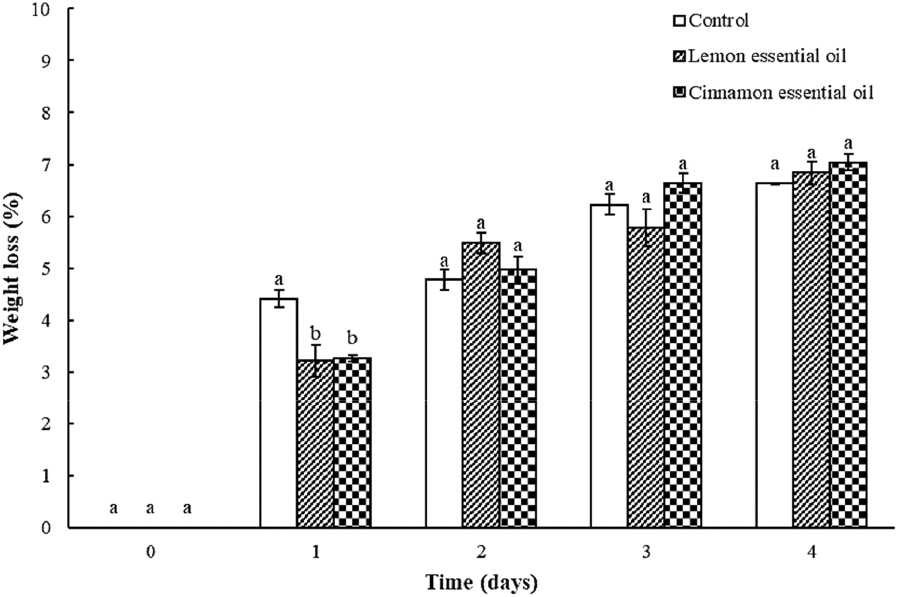
Color is one of the main factors that appeals to consumers when selecting fruit (Barrett et al., 2010). The surface color of strawberries was defined by measuring the lightness, hue (i.e., the tint), and chroma (i.e., the saturation), as shown in Fig. 2. Lightness and chroma decreased in time for all strawberries, regardless of the treatment (p<0.05). Hue remained constant through the experiment. Similar studies found comparable results with a loss of luminosity and color vividness in time (Perdones et al., 2012; Shehata et al., 2020; Wang et al., 2013). The loss of bright glossy red color in strawberries comes inevitably as storage time increases due to the degradation of anthocyanins, loss of water, and oxidation reactions (Holzwarth et al., 2012). However, strawberries treated with lemon essential oil tended to have a lighter color than the control after 2 d of storage, with a significant difference on the third day of storage. This difference did not subsist on day four. Lemon essential oil compounds might have participated in preserving pigments at the surface of strawberries for longer. Perdones et al. (2012) reported that strawberries treated with a lemon essential oil chitosan coating also had a slightly lighter color than control, as well as a redder tint.
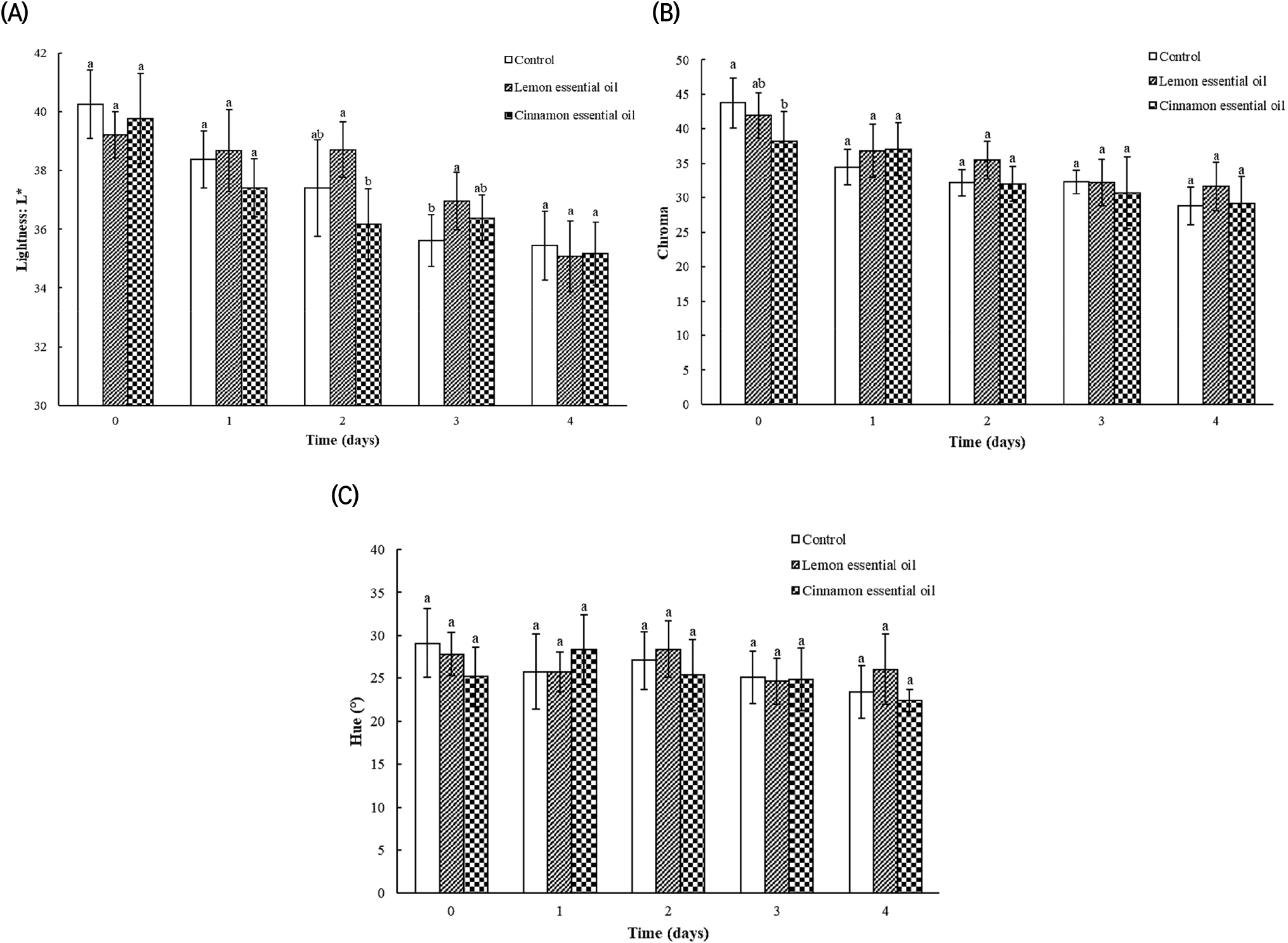
Strawberries treated with cinnamon essential oil vapor had no significant difference with control, except for chroma. It was lower immediately after treatment, meaning the strawberry had less saturated color. This difference disappeared early during the storage time. Similar studies on cinnamon essential oil incorporated in edible coatings or the vapor phase showed no effects of the oil on strawberry color (Tzortzakis, 2007; Wang et al., 2013).
Firmness is an essential factor in consumer acceptance (Barrett et al., 2010; Drobek et al., 2020). Strawberry texture is influenced by endogenous enzyme activities altering the chemical structure of the cell wall, resulting in softening of the fruit during ripening and storage (Azodanlou et al., 2004). Firmness decreased in time for all strawberries (p<0.05), as illustrated in Fig. 3. On average, a force of 8.0 Newtons was needed to squeeze the strawberries treated with lemon essential oil by 5 mm compared to 11.7 for the control on day two. This difference continued to increase on storage day three and four. Strawberries treated with lemon essential oil vapor became significantly softer starting the second day of storage. This loss of firmness might have been due to an increased breakdown of polysaccharides, fibers, and cell membranes due to contact with lemon essential oil acidic compounds (Cho and Buescher, 2012; Howard et al., 1994).
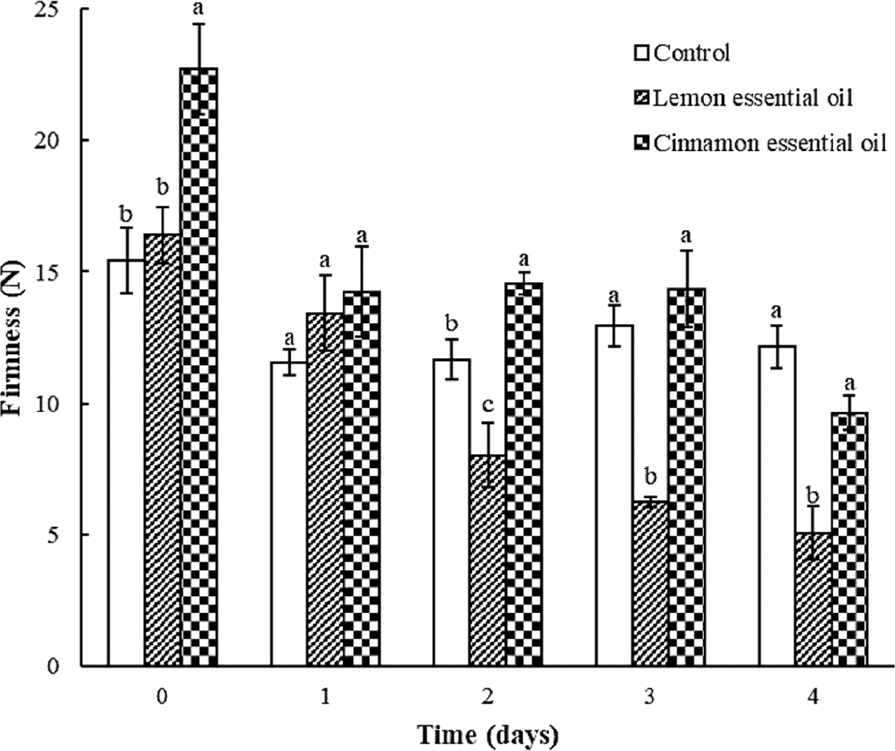
Cinnamon essential oil vapor significantly increased the firmness of strawberries immediately after treatment (day zero), with a force of 22.7 Newtons compared to 15.5 for the control (p<0.05). However, this difference disappeared after one day of storage. Afterwards, strawberries treated with cinnamon essential oils had a similar firmness to that of the untreated strawberries. These results were consistent with those of similar studies reporting that cinnamon essential oil treatment as vapor or in microemulsion did not affect the firmness of strawberries (Tzortzakis, 2007; Wang et al., 2013).
pH and titratable acidity are indicators of acidity in strawberries (Murti et al., 2012). pH is correlated with the concentration of hydrogen ions present, while titratable acidity is directly correlated with the content of organic acid present in the fruit (Shehata et al., 2020). Primary acids are citric acid and malic acid which are closely linked to the acidic taste to strawberries (Hwang et al., 2019). Organic acids can fluctuate based on microbial growth and metabolic activity (i.e., respiration) (Perdones et al., 2012). The effects of lemon essential oil vapor and cinnamon essential oil vapor on pH and titratable acidity are shown in Fig. 4(a) and (b). Lemon or cinnamon essential oil vapor treatment did not affect the pH and the concentration of citric acid in strawberries.
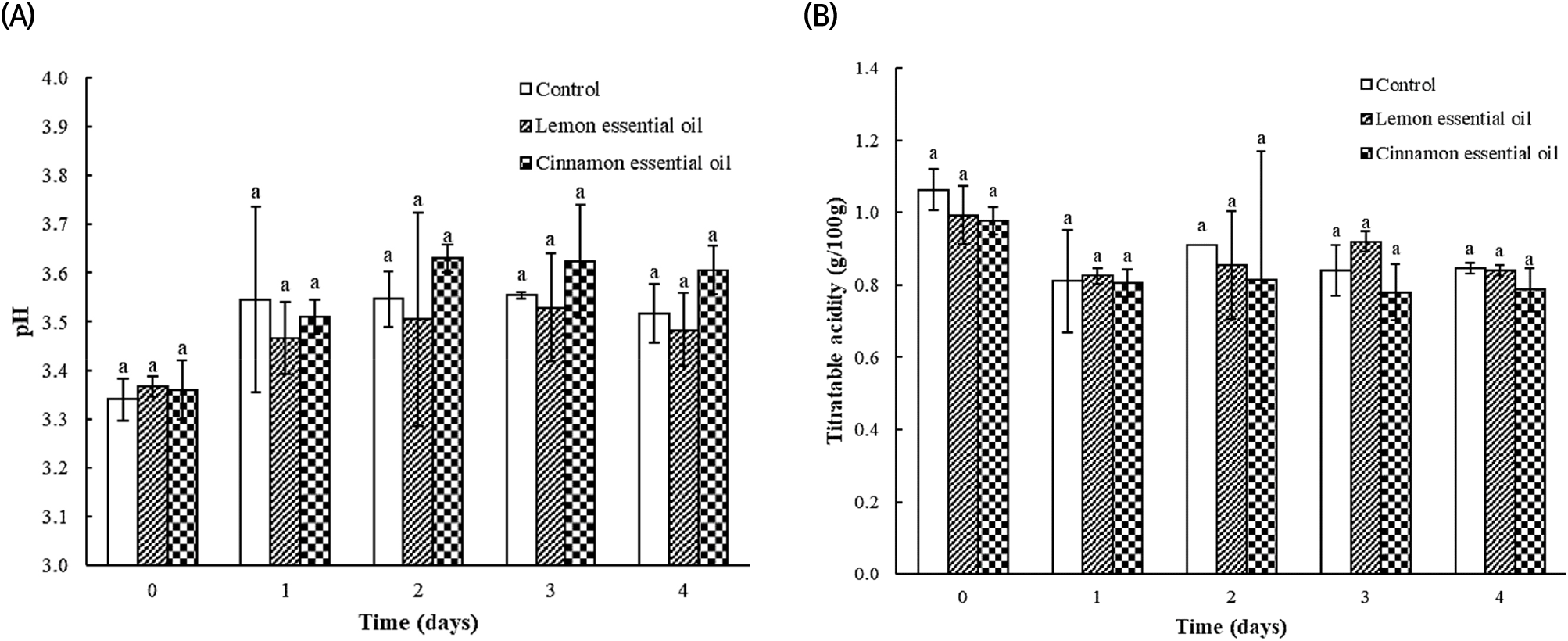
There were considerable variations of pH between individual strawberries within each group. Strawberries were selected based on their appearance (e.g., redness, texture profiles); however, their physical characteristics were not consistent with their acidity (Scott et al., 2021). It might explain why no difference was observed while previous studies have found a slight decrease in pH in the presence of lemon or cinnamon treatment compared to that in untreated strawberries (Perdones et al., 2012; Tzortzakis, 2007). Titratable acidity results were consistent with those reported by Perdones et al. (2012) and Tzortzakis (2007).
Soluble solid content corresponds to the soluble constituents in the fruit. They are mainly sugars, including fructose, glucose, and sucrose (Ornelas-Paz et al., 2013). During the ripening process, the concentration of soluble solids fluctuates depending on strawberry metabolism, time of harvest, and the cultivar of the strawberry (Azam et al., 2019; Hasing and Whitaker, 2014; Nunes et al., 2006). In this study, the soluble solids concentration in strawberries did not differ between treated and untreated strawberries, as shown in Fig. 5(a).
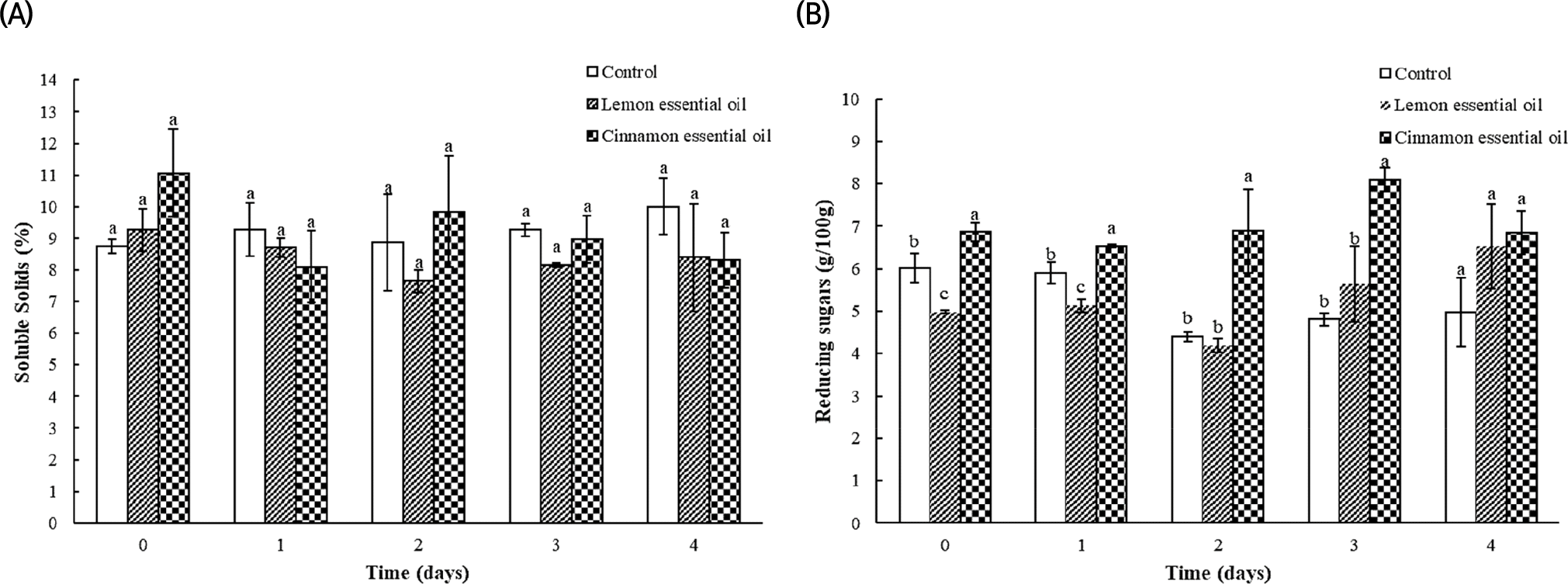
Reducing sugars have a free aldehyde or ketone group that is readily converted to a carboxylic acid by mild oxidants. Prevalent reducing sugars in strawberries are glucose and fructose. Several factors affect the concentration of reducing sugars in strawberries: during the ripening process, polysaccharides are hydrolyzed to smaller sugars and increased the amount of reducing sugars (Azam et al., 2019). However, microorganisms and strawberry cells can use these sugars and therefore decreasing their concentration. Also, these sugars could be oxidized/metabolized to other compounds (Liu and Tang, 2017). Currently, there is no literature on the effects of lemon or cinnamon essential oil on reducing sugars. Fig. 5(b) shows the reducing sugar concentration in strawberries for each treatment when stored at 22°C. The concentration of reducing sugars was lower in strawberries treated with lemon essential oil vapor compared to untreated strawberries during the first and second day of storage, which did not persist afterwards. Strawberries treated with cinnamon essential oil vapor showed a higher concentration of reducing sugars immediately after treatment, until day four. It is possible that cinnamon essential oil affects microbial growth and slows the ripening of strawberries by maintaining a reducing environment, leading to a higher amount of reducing sugars.
During this experiment, decay was visually assessed for each storage day, as shown in Fig. 6. Decay increased with time in treated and untreated strawberries (p<0.05). Lemon essential oil has been shown to have antifungal properties against some pathogens, including Botrytis cinerea, which is the primary cause of decay in strawberries (Dimić et al., 2014; Umagiliyage et al., 2017; Vitoratos et al., 2013). However, no differences were observed between the untreated strawberries and strawberries treated with lemon essential oil vapor. One possible reason is that species of fungi less sensitive to the oil could grow enough to be visible. Moreover, lemon essential oil significantly decreased the firmness of strawberries, which might have made the fruit surface more suitable for microbial growth.
Strawberries treated with cinnamon essential oil vapor did not show significant overall differences. As shown in Fig. 6, there was a tendency for treated strawberries to have less decay than untreated strawberries, with a percentage difference of 16.7% between the control and cinnamon essential oil on the fourth day, although the difference was not significant. Cinnamon essential oil has been shown to exert antimicrobial effects (Dimić et al., 2014; Ventura-Aguilar et al., 2018; Wang, et al., 2013; Xing et al., 2010). Tzortzakis (2007) also reported that strawberries exposed to cinnamon essential oil vapor for several days had a slower decay than the control. The lack of significant results in this study could be explained by the fact that the strawberry sample size was slightly small, decreasing the statistical power of the decay analysis. Further investigation with increased sample sizes would help establish the effects of cinnamon essential oil regarding the growth of visible mold.
A validation study was conducted at 4°C with 85% humidity for 18 d to test the cinnamon group in a practical and real storage condition. The percentage weight loss increased over time for the control and cinnamon essential oil vapor treatment (p<0.05), as shown in the Supplementary Fig. S1 and S2. Strawberries treated with cinnamon essential oil vapor had less weight loss than untreated strawberries until day seven. Afterwards, no differences was found between treatments and control.
Overall, strawberry firmness and color did not differ significantly when treated with cinnamon essential oil vapor compared to untreated. Cinnamon essential oil vapor treatment had a different effect immediately after treatment compared to the accelerated study, with a small decrease in lightness (p<0.05), and no change in chroma. These minor variations might be due to the sample size used in the experiment. Lightness and chroma decreased over time for all strawberry groups, which is comparable to the results of the accelerated shelf-life study. A minor decrease of hue was observed for all strawberry groups when stored at 4°C. The same tendency was detected in the accelerated shelf-life experiment, but the difference was not significant. Perdones et al. (2012) noticed a decrease of strawberry hue over time. Variations in hue might depend on the type of cultivar and method of storage. Overall, the findings of the validation study were similar to those of the accelerated shelf-life study.
pH and titratable acidity showed similar results between the cold storage and accelerated studies. pH ranged from 3.3 to 3.8, and titratable acidity ranged from 0.7 to 1 g per 100 g of strawberry, which is consistent with the current literature (Ali et al., 2011; Brown, 2019; Ornelas-Paz et al., 2013). Soluble solids concentration increased by 4% between the first and third day. Since the microbial growth is slowed by a low temperature (Ali et al., 2011), the ripening process may increase soluble solids in the strawberries. Soluble solids then decreased concurrently with the formation of mold on the surface of strawberries (data not shown). No difference was found between the control group and strawberries treated with cinnamon essential oil vapor.
Overall, there was a higher concentration of reducing sugars in strawberries, with a concentration of 5.5-10.5 g of sugar per 100 g of strawberries in the validation study compared to 4-8 g of reducing sugar per 100 g of strawberry in the accelerated study. Moreover, there was no difference between the control and the strawberries treated with cinnamon vapor in the validation study, in contrast to the accelerated study. This difference might be due to the decreased growth of microorganisms during cold storage, which leads to less consumption of reducing sugars. Since cinnamon essential oil has been shown to decrease microbial growth, the difference between treated and untreated strawberries was not observed in cold environments. More research is needed to confirm the potential connection between cinnamon essential oil treatment and increased reducing sugar levels.
This study has some strengths and limitations. It was the first study to investigate the effects of lemon essential oil in vapor state on strawberries. Moreover, it included a validation study confirming the effects found during the accelerated shelf-life research. One limitation was the small sample size of strawberries used in this experiment, which decreased the statistical power of this research. It might also explain the large standard deviations found for some results.
4. Conclusions
Lemon and cinnamon essential oils are part of the FDA GRAS list and possess antimicrobial properties, making them promising candidates as natural food preservatives (Al-Jabri and Hossain, 2016; Dimić et al., 2014; Fisher and Phillips, 2006; Umagiliyage et al., 2017; Vitoratos et al., 2013). Essential oils can carry bioactive compounds in their vapor phase, making them convenient fumigants for fruit preservation (Tzortzakis, 2007). Investigating the effects of such oils on the physicochemical parameters and of food items is crucial to determine their effectiveness. This study aimed to examine the effects of lemon or cinnamon essential oil vapor on several physicochemical characteristics of strawberries, including weight loss, color, firmness, sugar content, acidity, and visible decay. Lemon and cinnamon essential oils decreased water loss of strawberries at the beginning of storage. Lemon essential oil tended to delay the darkening process related to fruit aging but started decreasing firmness after 2 d of storage at 22°C; cinnamon oil altered firmness and color immediately after treatment, but the effects did not subsist during storage. Cinnamon essential oils increased the reducing sugars concentration in strawberries stored at 22°C during storage until the fourth day compared to untreated strawberries, but this effect was not present at the cold temperature. Lemon and cinnamon essential oil treatments did not alter the acidity profile of strawberries, nor their soluble solid content. They did not significantly decrease the visible decay over time, even though cinnamon essential oil treatment showed a tendency to delay it.
Overall, this research brings new light to the potential applications and limitations of essential oil vapor treatment for fruit fumigation, with promising results about their effects on the physicochemical parameters of strawberries. Further research is required to determine the optimum dosage and the effects of these oils on the organoleptic characteristics of fruits.











